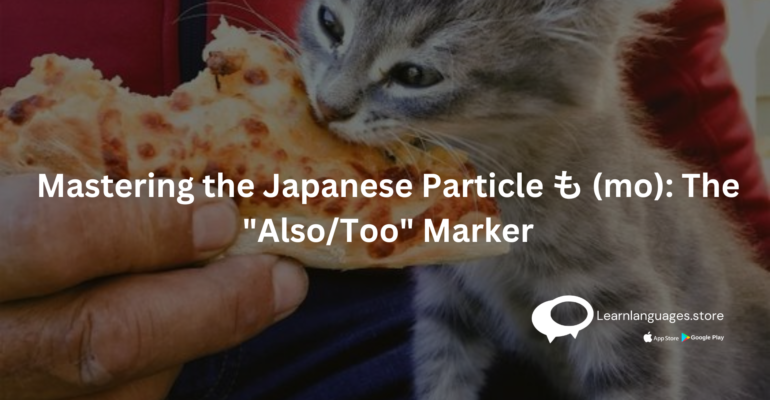Mastering the Japanese Particle も (mo): The “Also/Too” Marker
Mastering the Japanese Particle も (mo): The “Also/Too” Marker
Estimated reading time: 3 minutes

INTRODUCTION:
Welcome to our detailed guide on the Japanese particle も (mo)! This versatile particle is used to indicate “also” or “too” in Japanese sentences. Join us as we explore its usage with extensive examples, humor, and in-depth explanations.
Understanding も (mo)
The particle も (mo) is used in Japanese sentences to indicate that the subject or object also shares a characteristic or action mentioned earlier in the conversation. It functions similarly to the English words “also” or “too.”
Sentence Structure
The structure with も (mo) follows this pattern:
[Subject/Object] も [Predicate]
- English: [Subject/Object] also [Predicate]
- Japanese: [Subject/Object] も [Predicate]
- Hindi: [कर्ता/वस्तु] भी [विधेय]
Examples
Let’s dive into some examples to understand the usage of も (mo) better.
- Simple Addition:
- 私も行きます。
- Romaji: Watashi mo ikimasu.
- Pronunciation (Hindi): वातासि मो इकिमासु।
- English: I will also go.
- Hindi: मैं भी जाऊँगा।
- 私も行きます。
- Including Another Person:
- 彼も学生です。
- Romaji: Kare mo gakusei desu.
- Pronunciation (Hindi): कारे मो गाकुसेइ देसु।
- English: He is also a student.
- Hindi: वह भी छात्र है।
- 彼も学生です。
Fun and Humorous Examples
Learning becomes more enjoyable with humor! Let’s explore some funny scenarios involving も (mo).
- Shared Love for Food:
- 猫もピザが好きです。
- Romaji: Neko mo piza ga suki desu.
- Pronunciation (Hindi): नेको मो पिज़ा गा सुकी देसु।
- English: The cat also likes pizza.
- Hindi: बिल्ली को भी पिज़ा पसंद है।
- 猫もピザが好きです。
- Everyone Loves Sleeping:
- 犬も昼寝をします。
- Romaji: Inu mo hirune o shimasu.
- Pronunciation (Hindi): इनु मो हिरुने ओ शिमासु।
- English: The dog also takes naps.
- Hindi: कुत्ता भी दोपहर की नींद लेता है।
- 犬も昼寝をします。
Identifying も (mo) in a Sentence
Identifying the Japanese particle も (mo) in a sentence is crucial for understanding its function. Here’s how you can spot it:
- Look for も (mo) after the subject or object in the sentence.
- It indicates that the subject or object shares the characteristic or action mentioned earlier.
For example:
- 彼も来ます。 (Kare mo kimasu.)
- In this sentence, “彼” (kare) means “he” and “来ます” (kimasu) means “will come.” も (mo) indicates that he, like others previously mentioned, will also come.
Conclusion
Congratulations! You’ve now mastered the Japanese particle も (mo) and its versatile role as a marker for “also” or “too.” By understanding its usage in sentence structure and exploring humorous examples, you’ve taken a significant step forward in your journey to fluency in Japanese.
Keep practicing with different scenarios and contexts to solidify your understanding of も (mo). Embrace the challenges and enjoy the process of mastering Japanese grammar.
With each step you take, may your confidence in using も (mo) grow, enabling you to express inclusivity and shared characteristics with ease in Japanese. Happy learning!
-
Product on sale
 Japanese N4
Japanese N4₹18,300.00
₹24,300.00 -
Product on sale
 Japanese N5
Japanese N5₹16,300.00
₹18,300.00
Learn Languages Store
Vashi,
Email: services@learnlanguages.store










